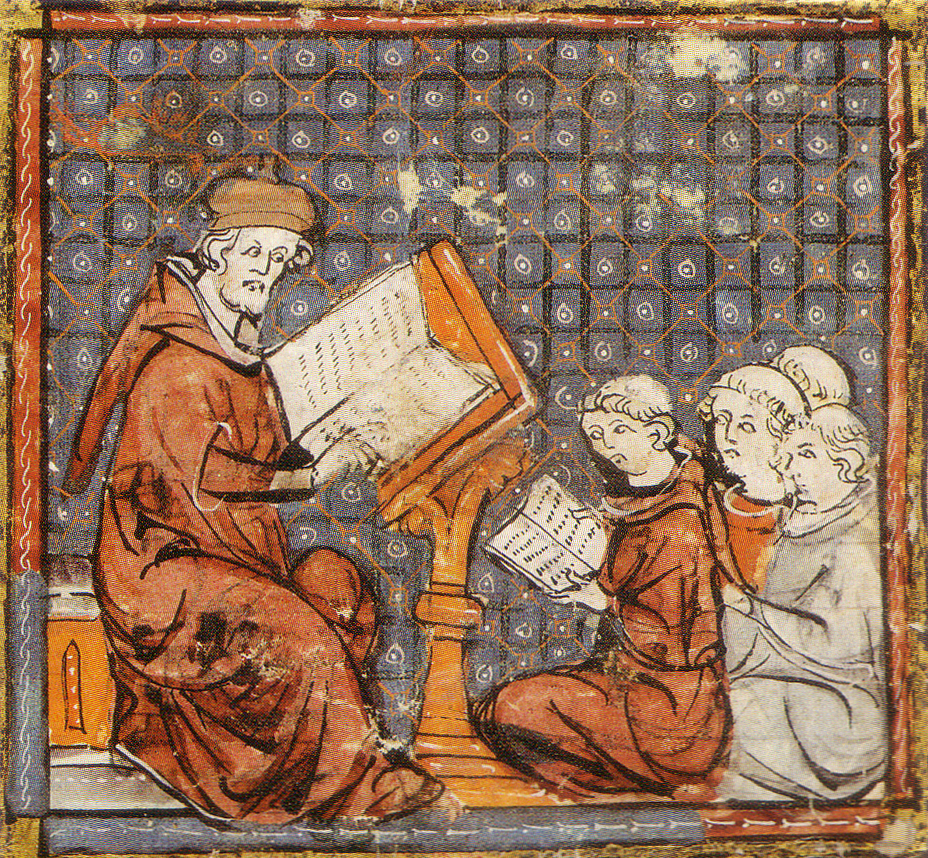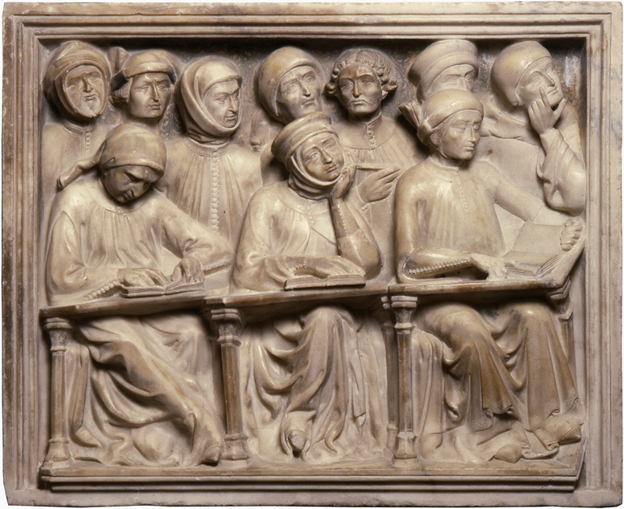07: The World of Learning
“higher” education: assumes a level of previous schooling
Recovery of ancient knowledge, plus modern innovations
Regional variations north and south
Paris

Paris, 14th c lecture. Grandes chroniques de France. – Castres, bibliothèque municipale, ms. 3, f. 277r
Northern Europe: main schools are church-based (monastic or cathedral), from 11th c reforms
Paris: important cathedral school
- Focus on logical analysis, argumentation
- Guild model: mastering the art of instruction
- Papal attention: Innocent III, Honorius III, Gregory IX
- 1231 Gregory IX grants Paris a charter: ius ubique docendi
- Other northern cities follow Paris model
Bologna:

Fragment from the tomb of jurist Giovanni da Legnano, Medieval Museum, Bologna
Legal studies center by era of Investiture controversy
Also medicine
Corporate body of students to regulate instruction; then professors
Other Italian cities follow Bologna model; Rome in 1240s
University education and higher clergy
Conflicts over expertise and authority between universities, papacy
Curriculum and organization of subjects
- Four main faculties: arts, law, medicine, theology
- 4-5 years at least for B.A.
- 3-5 with teaching M.A.
- Doctorate: higher faculties
- Liberal arts: trivium (grammar logic rhetoric); quadrivium (arithmetic, geometry, astronomy, music); “old” Aristotle
- New translations of ancient texts (Greek to Latin)
New translations of Arabic scholarship (commentaries, new works)
Aristotle, (some) Galen, many more
Logic as key method field
Lecture
Disputatio
Rome
- 1244-5 Innocent IV: Studium Romanae Curiae
- 1303 Boniface VIII: bull grants rights to Studium Urbis
- 1318 rights affirmed to award degrees in civil and canon law
- Funding: taxes on subject towns such as Tivoli
- Theology: mendicants, notably Dominicans (Santa Sabina 1219: Honorius III)
- Location: near Sant’Eustachio
1370s classes moved to Trastevere
1406 Innocent VII plans to renew university: bull written by Leonardo Bruni
1431 Eugenius IV did renew university
New funding source: tax on imported wine sold in city taverns (17.5%); moved back to Sant’Eustachio Major growth 15th c
Part 2: the Humanist Movement
“rebirth” of letters:
- Recovery of ancient texts, literature
- Writing new works
Earliest centers: Padua, Florence.
Rome: 15th+
Private (otium); education (outside university); new career paths; university
Who are our humanists?
- Advocates of a curriculum based on ancient writers, emphasizing eloquent writing (studia humanitatis)
Grammar, rhetoric, poetry, history, moral philosophy
Rhetoric as key discipline
- career paths: urban “Man of letters”: secretary, diplomat, notary, teacher, administrator
- reader, writers, editors of classical literature, Greek and Roman
founders of first major European libraries devoted to open access and research
Why ancient models?
- ancients wrote better, more eloquently
- humanistic studies mold character
- Note: sciences are not affected by this at first
Vernacular as well: medieval models (Provencal)
Francesco Petrarca (1304-74) and Rome
- Exiled Florentine family
- 1312 Avignon
- University (Montpellier-Bologna)
- Back to Avignon: household of cardinal, Giovanni Colonna until 1337
- Livy and Rome
- 1337 first visit to Rome; 1340 crowned as poet on Capitoline by Robert King of Naples
- 1345 Discovery of Cicero’s letters
- other literary model: Augustine (354-430), who combined eloquence with Christian faith
- Support for Cola di Rienzo
Rome: ancient grandeur, modern squalor

Bruni, portrait from Bib. Med. Laurenziana
Leonardo Bruni (c. 1370-1444): Florence with Roman connections
From Arezzo, to Florence to study law; interested in Greek, other humanistic studies
Friend of Poggio Bracciolini
Apostolic secretary: Innocent VII, stayed to work for Gregory XII and Alexander V
1410-11 in Florence as chancellor
1411 Rome: secretary to John XXIII (Council of Constance)
Then back to Florence, chancellor 1427-44
Poggio Bracciolini (1380-1459)
- near Arezzo, to Florence to study notarial arts (age 16-17)
In Florence: like Bruni, circle of Coluccio Salutati; Greek language, textual editing
Apostolic secretary: John XXIII (Council of Constance); manuscript collecting Cluny, Fulda, St. Gall
1417-23 England
Papal secretary: Martin V, Eugene IV, Nicholas V
Handwriting reform
Facetiae: in print by 1470 1472 edition
Poggio Bracciolini’s preface to trans. of Diodorus Siculus’ Bibliotheca historica. Dedication copy to Nicholas V. Vatican City, Biblioteca Apostolica Vaticana, Vat. lat. 1812, fol. 1r.
Rome as location for humanists’s career paths
- New church administration/bureaucracy
- Natural humanist interest in Rome
